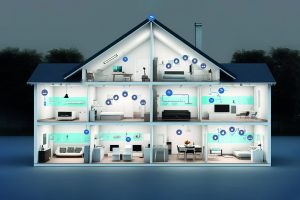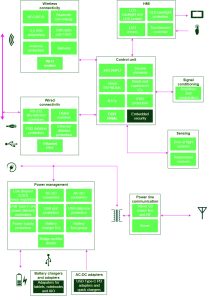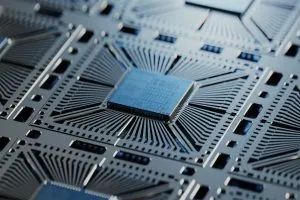
Advanced home automation with integrated IoT systems for security, smart lighting, climate control and energy management (Source: AdobeStock)
First there was clapping to activate light switches, then voice-activated speakers taking song requests and now, with the explosion of AI, smart homes are progressing to the next level.
There are thousands of smart home examples, planned and yet to be imagined. Your doorbell will recognise you, sense how you feel (emotion recognition) and activate just the right lighting, music, temperature and scent for the circumstances. Your living room TV will know who is in the room, which channels are their favourites and who has fallen asleep on the couch. Your washing machine will distinguish whites from coloureds and subtle hand gestures will become the new handclap.
As applications proliferate, devices will get smarter, smaller and more power-efficient, connected and integrated. Here are six key challenges to consider for smart home devices.
Locating the AI
Why send private data to the cloud when it can be stored locally? While a vacuum cleaner’s data need not be sent to the cloud, product designers are moving AI to the edge. One example is NXP’s portfolio of microcontrollers, application processors and microprocessors optimised for machine-learning applications in a range of residential and commercial applications.
For a long time now the Achilles’ heel of home automation has been the hub. Virtually every device depends on a proprietary connectivity protocol, creating vendor lock-in, extra expense and one more device to manage. No one wants to have to buy 10 hubs for 10 smart home devices, they want one hub – or better yet, a direct connection to the home’s router.
Both Bluetooth Mesh and Zigbee networks are excellent options. They share more similarities than differences. Modern hardware, such as STMicroelectronics’ STMWB55 series of systems on chips, supports Zigbee and Bluetooth Mesh networks. Zigbee is better suited for larger networks and low-power applications. It offers better scalability and security, but with tradeoffs such as limited range and slower data transfer rates. Conversely, Bluetooth is suitable for smaller networks and high-speed data transfers. It provides less scalability, with a shorter range and high power consumption.
Wi-Fi 6 introduces improved speeds, bandwidth, battery life, security and reliability to the wireless standard. Additionally, it can support multiple devices simultaneously, allowing families to stream music or movies without interrupting other applications.
Power management
Connecting smart home devices means preserving batteries in those products that do not plug in to mains power. Optimising power consumption entails a series of processes: hardware energy optimisation, network optimisation, software energy optimisation and perhaps energy harvesting. A device designer will want to select an energy-efficient microcontroller for IoT applications. Computational requirements may require an 8-bit or a 32-bit microcontroller, but energy requirement is a significant parameter for selection.

Home automation bridge and gateway integrating heterogeneous smart things
The distance between two nodes, topology, the data rate and the message size also influence power consumption. Programming a device in low-power and active modes will help extend battery power. New developments in low-power management have launched a wide range of low-power sleep modes that provide more acceptable levels of granularity beyond just run or idle modes. They include standby, doze, sleep and deep sleep.
The application should be programmed to spend as little time as possible in the microcontroller’s ‘active’ mode. It might mean simplifying calculations, batching operations, or transitioning to an asynchronous and interrupt-driven design. A designer could also look for opportunities to harvest ambient energy, for example, solar.
To choose the right battery, first consider the power demands of the device and the desired runtime. To calculate the capacity of the battery needed, multiply the average current expected to be drawn from the battery by the number of hours of expected use. Next, ensure the battery performs as advertised because there can be inconsistencies among batches.
The most important consideration is designing for realistic use cases. For example, if the device is a smartphone, the real use case will vary widely by user. Each use case would include a sequence of talking, texting, accessing webpages, streaming video, playing games and listening to music.
In low-power, battery-operated devices, minimising power consumption is crucial for extending battery life. Consider an operational amplifier with a low quiescent current to reduce the overall power consumption of the circuit. This is especially important for devices that operate in sleep and hibernate modes for extended periods, where quiescent current becomes the most significant contribution to standby power consumption.
The MAX40108 1V op amp from Analog Devices is one option for these applications, as it features low quiescent current and high precision, and operates on a power supply voltage as low as 0.9V. Using this op-amp can significantly increase battery life in battery-powered sensor systems.
Miniaturisation
Small is better in home automation circuitry. Today a complete radio module can sit inside a light bulb. Even more impressive is the fact that a small microcontroller chip can run an entire machine-learning algorithm.
For example, system designers are constantly challenged to deliver more nuanced image and facial recognition from smaller, lower-powered devices at the edge. Many customers want 3D facial recognition.
Analog Devices’ MAX78002 is an AI microcontroller that can run convolutional neural networks at lower power at the edge of the IoT. Similarly, speech recognition, requiring graphics processing units, can now be achieved by FPGAs that deliver power-efficient, edge-based designs, including Xilinx’s Vitis.
Finally, with products changing so fast, how can we ensure they last? One way is taking a hard look at wide bandgap semiconductor materials such as SiC and GaN. These semiconductors offer higher performance with less energy consumption and potentially superior lifetime than silicon-based ones.
Another way is to ensure all devices can be easily updated wirelessly.
These are just some of the design decisions to consider when designing smart products to make homes more comfortable to inhabit and manage.
Visit Avnet at electronica 2024: B5-103
 Electronics Weekly
Electronics Weekly



